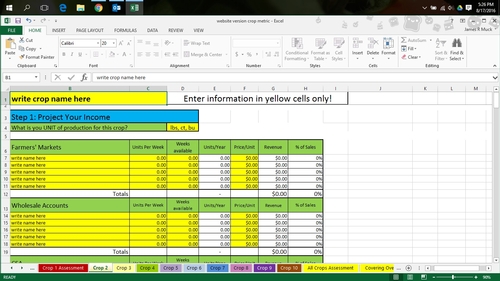Harvesting Data
Summer is in full tilt and every farmer and rancher I know is working like crazy just to keep up. There is always lots and lots of work to do on the farm, but one area most of us ignore is the office work. This is especially true during the busiest times of the year, like spring planting and fall harvest. Sorry to add a burden to the already overworked farmer, but everyone should make some time to work on their business this time of the year.
Summer is the best time to monitor and record labor times for things like prepping ground for cover crops, prepping crop beds, and fall planting. If you can make the effort to record this data now while you are doing the work, you can use these accurate numbers to help you calculate your labor costs and know your true costs of production. If you don't record the information now, then the data you use for your production cost calculations will just be a good guess. Make the investment now so that you can have the best information possible.
You might be like lots of farmers and have never figured out how much it really costs to produce a crop. Most farmers work like crazy in the spring to get the crops planted, then they nurture the crops on through to harvest, and finally they sell their crops. At the end of the year, they add up the expenses and compare that number to the sales receipts and know if they made a profit or suffered a loss. This method is simple and easy, but not accurate. When you look at your numbers this way you fail to take into account the cost of owner labor in producing your crops. If you have hired workers you know how much that costs, because you wrote the paychecks, but what about your (the owner's) labor? Did you track how many hours you sat on the tractor mowing, discing, or cultivating? If you didn't, then you really don't know how much your crop cost you to grow. If you don't know how much it costs to grow a crop, then how can you determine its sale price? You don't want to sell your product for less then what it costs to grow, do you?
Summer is not the only time for you to collect information. Keep that notebook with you throughout the farming year and record how much time it takes to perform all of the work that goes into a crop, including harvest, packing, and weeding. The idea is to learn as much as you can about each of your crops. To do this you will need to keep records for each crop. For example: if you grow carrots, collect data that pertains only to carrots. You can make your numbers look really bad if you add in the time it took to weed the chard with the time it took to weed the carrots. The carrot numbers need to stay separate from the chard numbers and vice versa. If you grow lots of crops this is going to sound overwhelming, so don't try to collect all that data in the first year. Start collecting numbers for your main crops and then move on to the minor crops. A good goal would be to record everything you can on your three biggest crops this year.
Once you have this information, do some calculations. To help you with the math, we have created the “Crop Profitability Calculator” that you can download from our website. The calculator uses Excel spreadsheets and will crunch the numbers for you. To get to our website click on the link below:
http://ucanr.edu/sites/placernevadasmallfarms/
Once on our website, you will see a large blue box on the right side of the page that reads “Which crops make the most money on your farm?” Click on the link in the box to go to the calculator. Or you can click this link:
http://ucanr.edu/sites/placernevadasmallfarms/UCCE_Enterprise_Calculators/
Remember: Rome wasn't built in a day, so start small. Collect the numbers and a start filling in the profitability calculator. If you take some time each week to work on your business, before you know it you will have a much better picture of your costs of production. This allows you to make informed decisions. Knowledge is power, so gain the knowledge and put the power to work on your business.




